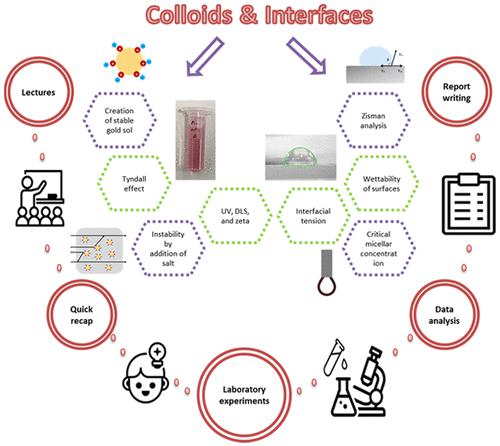当前位置:
X-MOL 学术
›
J. Chem. Educ.
›
论文详情
Our official English website, www.x-mol.net, welcomes your feedback! (Note: you will need to create a separate account there.)
Colloids and Interfaces: Where Science Meets Engineering, a Hands-on Learning Approach
Journal of Chemical Education ( IF 3 ) Pub Date : 2024-04-01 , DOI: 10.1021/acs.jchemed.3c01218 Panchami Patel 1 , Prachi Thareja 1
Journal of Chemical Education ( IF 3 ) Pub Date : 2024-04-01 , DOI: 10.1021/acs.jchemed.3c01218 Panchami Patel 1 , Prachi Thareja 1
Affiliation

|
This article describes two sets of experiments designed to enhance the understanding of colloidal systems. These experiments were designed as a part of the theme “Colloids: Where Science Meets Engineering” taught in the Department of Chemical Engineering and additionally offered to physics, chemistry, and materials science departments as an advanced course at IIT Gandhinagar, India. Through this article, we describe experiments planned and conducted simultaneously with the course content to improve the student interaction with the subject matter and enhance their learning. The first set of experiments deals with preparing and characterizing gold nanoparticle sol and observing phenomena such as the Tyndall effect and aggregation with the addition of salt by UV analysis, DLS sizing, and zeta potential measurements. The second set of experiments deals with understanding interfaces, including contact angle, surface tension, critical micellar concentration of surfactants, and surface energy. The students are not only able to visualize course content but also exposed to the lab environment, learn basic preparation protocols, and handle or observe the application of high-tech equipment. Thus, this article aims to help develop further teaching protocols for instructors with similar course plans by suggesting key experiments that are easy to perform along with the course and facilitate student learning.
中文翻译:

胶体和界面:科学与工程的结合,实践学习方法
本文介绍了两组旨在增强对胶体系统的理解的实验。这些实验是化学工程系教授的主题“胶体:科学与工程相遇的地方”的一部分,另外还作为印度印度理工学院甘地讷格尔分校的物理、化学和材料科学系的高级课程提供。通过本文,我们描述了与课程内容同时计划和进行的实验,以改善学生与主题的互动并增强他们的学习。第一组实验涉及金纳米粒子溶胶的制备和表征,并通过 UV 分析、DLS 尺寸测量和 zeta 电位测量观察廷德尔效应和添加盐时的聚集等现象。第二组实验涉及了解界面,包括接触角、表面张力、表面活性剂的临界胶束浓度和表面能。学生不仅能够直观地看到课程内容,还能够接触实验室环境,学习基本的准备方案,并处理或观察高科技设备的应用。因此,本文旨在通过建议易于与课程一起执行并促进学生学习的关键实验,帮助具有类似课程计划的教师制定进一步的教学方案。
更新日期:2024-04-03
中文翻译:

胶体和界面:科学与工程的结合,实践学习方法
本文介绍了两组旨在增强对胶体系统的理解的实验。这些实验是化学工程系教授的主题“胶体:科学与工程相遇的地方”的一部分,另外还作为印度印度理工学院甘地讷格尔分校的物理、化学和材料科学系的高级课程提供。通过本文,我们描述了与课程内容同时计划和进行的实验,以改善学生与主题的互动并增强他们的学习。第一组实验涉及金纳米粒子溶胶的制备和表征,并通过 UV 分析、DLS 尺寸测量和 zeta 电位测量观察廷德尔效应和添加盐时的聚集等现象。第二组实验涉及了解界面,包括接触角、表面张力、表面活性剂的临界胶束浓度和表面能。学生不仅能够直观地看到课程内容,还能够接触实验室环境,学习基本的准备方案,并处理或观察高科技设备的应用。因此,本文旨在通过建议易于与课程一起执行并促进学生学习的关键实验,帮助具有类似课程计划的教师制定进一步的教学方案。



























 京公网安备 11010802027423号
京公网安备 11010802027423号